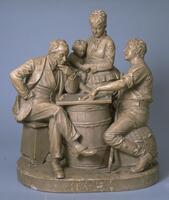19 UMMA Objects
19 UMMA Objects
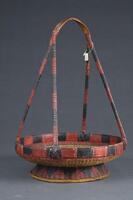
Chinese (Chinese (culture or style))
Flower Basket
20th century
Gift of Ellen and Richard Laing
2006/2.35
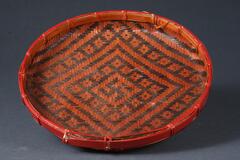
Chinese (Chinese (culture or style))
Flat Basket with swastika motif, from Taiwan
20th century
Gift of Ellen and Richard Laing
2006/2.36
![A corn husk woven basket with wooden shaping dowels. One side of the rectangle is flat while the other end is curved. There are two blue stripes on the inside floor of the basket and green and purple designs on the outside.<br />
<br />
This straw basket (<em>samtaegi</em> ) is woven from dyed straw. The round frame at the back of it is made from bitterwood and the front part from bamboo. Judging from the use of dyed straw, this basket was probably used for drying grain such as soy beans.
<p>[Korean Collection, University of Michigan Museum of Art (2017) p. 277]</p>
A corn husk woven basket with wooden shaping dowels. One side of the rectangle is flat while the other end is curved. There are two blue stripes on the inside floor of the basket and green and purple designs on the outside.<br />
<br />
This straw basket (<em>samtaegi</em> ) is woven from dyed straw. The round frame at the back of it is made from bitterwood and the front part from bamboo. Judging from the use of dyed straw, this basket was probably used for drying grain such as soy beans.
<p>[Korean Collection, University of Michigan Museum of Art (2017) p. 277]</p>](/media/W1siZiIsIjIwMjIvMDkvMjQvZmVlMTZ2YW0yX2RlZmF1bHQuanBnIl0sWyJwIiwidGh1bWIiLCIyNDB4MjAwIl1d?sha=63e41f30e2d00ee4)
Korean (Korean (culture or style))
Winnowing Basket
1850 – 1950
Gift of Ok Ja Chang and the Chang Family
2009/2.49
![A rectangluar box woven with bamboo. There is a strip of bamboo with a clasp to keep the basket closed and in one piece. Used as a fermer's lunchbox.<br />
<br />
This lunchbox is woven from strips of bamboo. The outer part is plain-woven, while the inner part is woven in the style of a reed mat. The frame is made from bands of bamboo tied together in two places. Lunchboxes such as this one were used to deliver meals to those working in fields.
<p>[Korean Collection, University of Michigan Museum of Art (2017) p. 278]</p>
A rectangluar box woven with bamboo. There is a strip of bamboo with a clasp to keep the basket closed and in one piece. Used as a fermer's lunchbox.<br />
<br />
This lunchbox is woven from strips of bamboo. The outer part is plain-woven, while the inner part is woven in the style of a reed mat. The frame is made from bands of bamboo tied together in two places. Lunchboxes such as this one were used to deliver meals to those working in fields.
<p>[Korean Collection, University of Michigan Museum of Art (2017) p. 278]</p>](/media/W1siZiIsIjIwMjIvMDkvMjQvMW04NXo0anoyNl9kZWZhdWx0LmpwZyJdLFsicCIsInRodW1iIiwiMjQweDIwMCJdXQ?sha=39da02e99668303f)
Korean (Korean (culture or style))
Farmer's Lunchbox
1850 – 1950
Gift of Ok Ja Chang and the Chang Family
2009/2.50
![A wide cylindrically-shaped basket with an opening at the top. Used to store seeds while farmers would walk and scatter them to plant.<br />
<br />
This seed pouch is made by weaving double strips of Korean moonseed, following the method of weaving a straw mat. It was used to store seeds or when plating them.
<p>[Korean Collection, University of Michigan Museum of Art (2017) p. 277]</p>
A wide cylindrically-shaped basket with an opening at the top. Used to store seeds while farmers would walk and scatter them to plant.<br />
<br />
This seed pouch is made by weaving double strips of Korean moonseed, following the method of weaving a straw mat. It was used to store seeds or when plating them.
<p>[Korean Collection, University of Michigan Museum of Art (2017) p. 277]</p>](/media/W1siZiIsIjIwMjIvMDkvMjQvNGtqOG4ycmlsMV9kZWZhdWx0LmpwZyJdLFsicCIsInRodW1iIiwiMjQweDIwMCJdXQ?sha=df082d9928744ecc)
Korean (Korean (culture or style))
Seed Planting Basket
1850 – 1950
Gift of Ok Ja Chang and the Chang Family
2009/2.54
![A rectangluarly shaped woven basket with rounded edged. The bottom half and the lid of the basket are trimmed with strips of pine. The two pieces are of two slightly different sizes, making the lid fit into the bottom piece.<br />
<br />
These wicker baskets are rimmed with willow strips on both the interior and the exterior. Wicker baskets such as these were used as sewing baskets, food containers, or for other various purposes. The willow strips are sewn firmly together at their joints. On one each side of the lid and body of plate 358 (2009/2.56) is a faded inscription written that reads “Seong □ 2-gu Bongsandaek (성□2구 봉산댁; possibly a reference to a lady from Bongsan, living in Seong □ 2 [i]-gu).”
<p>[Korean Collection, University of Michigan Museum of Art (2017) p. 278]</p>
A rectangluarly shaped woven basket with rounded edged. The bottom half and the lid of the basket are trimmed with strips of pine. The two pieces are of two slightly different sizes, making the lid fit into the bottom piece.<br />
<br />
These wicker baskets are rimmed with willow strips on both the interior and the exterior. Wicker baskets such as these were used as sewing baskets, food containers, or for other various purposes. The willow strips are sewn firmly together at their joints. On one each side of the lid and body of plate 358 (2009/2.56) is a faded inscription written that reads “Seong □ 2-gu Bongsandaek (성□2구 봉산댁; possibly a reference to a lady from Bongsan, living in Seong □ 2 [i]-gu).”
<p>[Korean Collection, University of Michigan Museum of Art (2017) p. 278]</p>](/media/W1siZiIsIjIwMjIvMDkvMjQvNG0xb3JlcWlnMV9kZWZhdWx0LmpwZyJdLFsicCIsInRodW1iIiwiMjQweDIwMCJdXQ?sha=349fad738bc188d5)
Korean (Korean (culture or style))
Lidded Basket for Sewing
1850 – 1950
Gift of Ok Ja Chang and the Chang Family
2009/2.51
![A pillow-shaped woven basket with a lid used for storing sewing materials. Made of two parts, each with a lip of pine. The two pieces are sized differently in order to fit together as a lidded container.<br />
<br />
These wicker baskets are rimmed with willow strips on both the interior and the exterior. Wicker baskets such as these were used as sewing baskets, food containers, or for other various purposes. The willow strips are sewn firmly together at their joints. On one each side of the lid and body of plate 358 (2009/2.56) is a faded inscription written that reads “Seong □ 2-gu Bongsandaek (성□2구 봉산댁; possibly a reference to a lady from Bongsan, living in Seong □ 2 [i]-gu).”
<p>[Korean Collection, University of Michigan Museum of Art (2017) p. 278]</p>
A pillow-shaped woven basket with a lid used for storing sewing materials. Made of two parts, each with a lip of pine. The two pieces are sized differently in order to fit together as a lidded container.<br />
<br />
These wicker baskets are rimmed with willow strips on both the interior and the exterior. Wicker baskets such as these were used as sewing baskets, food containers, or for other various purposes. The willow strips are sewn firmly together at their joints. On one each side of the lid and body of plate 358 (2009/2.56) is a faded inscription written that reads “Seong □ 2-gu Bongsandaek (성□2구 봉산댁; possibly a reference to a lady from Bongsan, living in Seong □ 2 [i]-gu).”
<p>[Korean Collection, University of Michigan Museum of Art (2017) p. 278]</p>](/media/W1siZiIsIjIwMjIvMDkvMjQvOGJ6dWJ2eXd1ZV9kZWZhdWx0LmpwZyJdLFsicCIsInRodW1iIiwiMjQweDIwMCJdXQ?sha=b20483f9f781a9cc)
Korean (Korean (culture or style))
Lidded Basket for Sewing
1850 – 1950
Gift of Ok Ja Chang and the Chang Family
2009/2.56
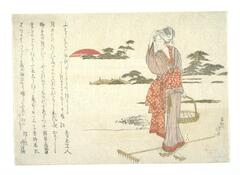
Katsushika Hokusai
Sunrise at Susaki Point (New Year's Print)
1800 – 1820
Bequest of Margaret Watson Parker
1954/1.472
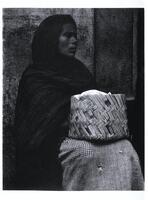
Paul Strand (American (North American))
Woman, Patzcuaro
1933
Gift of Mr. and Mrs. Philip C. Davis through the Friends of the Museum of Art
1971/2.126.6
Loading…
